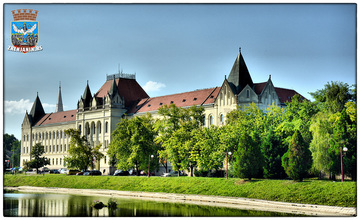History

The Middle Ages
The first historical records mentioning Zrenjanin (Bečkerek) date from the 14th century, the time when the Hungarian king Karlo I (1301-1342) used to visit Banat and spent most of his time in his capital Temišvar. Many noblemen came with him, among which the most powerful Imre Bečei was. He settled down in “Bechereki” and “Beche” (Novi Bečej), the names refer to his surname. In region of today’s Zrenjanin an inscription – Karlo I a coin has been found .
The oldest written records of Bečkerek date from Budim Capitulum’s document of collecting Pope’s tens taxes in 1326, 1331 and 1332. judging by the size of the tens Bečkerek of 1330’s was an average village. The first settlers were the landless Hungarian peasants - jobagyi. There were the Serbs in Banat, too. The Great Migration of Nations brought them here. During Lajoš the Great reign (1343-1382) more Serbs from the south came, among which many Orthodox priests. In the 15th century Bečkerek became Serbian place mostly. But after the Kosovo battle (1389), the Turks came to this area, too.
After the Turkish victory at the battle at Nikopolje (1396) the Hungarian King Sigismund (1387-1437) was considering the defending of the territory settled by the Serbs. Probably that was the reason, why the King visited Bečkerek on September 30th, 1398. The town was granted to Stefan Lazarević at the end of the 1403. The despot became the vassal of Hungarian King; but he got Bečkerek and the title of the Great Head of the Tribal State of the Torontal tribal state.
Bečkerek under the Turks
The Hungarian King Ferdinand appointed the friar Djordje Martinović, a commander of his forces, to defend the town from the Turks. Hungary was attacked by 80,000 Turk soldiers under the command of Turk’s bey Mehmed-Pasha Sokolović. On September 15th 1551, the siege of the town Bečej was raised and the town was taken after four days. On September 24th the Bečkerek fortress was sieged. Many people left town earlier and with few defenders the town couldn’t be defended and those eighty, who left surrendered the next day. For the commander of Bečkerek was appointed the bey Malković by Pasha. After the Turks had taken Temišvar in 1952, Banat became the special province (ejalet, vilayet, pashadom) with a beglerbey on head, whose headquarters were in Temišvar. The ejalet was divided into more districts.
Bečkerek became the headquarters of one of the districts, with a bey on head. During the occupation, the executive authority had military character. The only exceptions were the emperor’s towns. Bečkerek wasn’t declared for such a town, but it was very close to become such a town. This was as a result of a good behaviour of the Serbs toward the Turks, and according to the Sultan’s edict the inhabitants were free of pay of war taxes. During the Turks reign of 165 years, Bečkerek consisted of two separate settlements: the settlement of Bečkerek, the village Gradna Street (Gradnulica). The town was divided into two parts, the Turkish and Serbian.. The Turkish part was fenced and closed, but the Serbian one was open.
On the main square there was a large mosque built and inside the fortress there was a little one. There was a Turkish bath, and around it there were about twenty stores. Gradna Street was a disorderly village, whose centre was approximately on the crossroad of the present streets Sindjelićeva and Djurdjevska. The citizens of Bečkerek, except the crew of the fortress had been Serbs, before the Turks came. The number of the Turks families was about fifty at the end of 18th century.
According to the Karlovac Peace Treaty, in the year 1699, the Temišvar province (including Bečkerek) stayed under Turks reign, but the Austrian forces which had taken this part of Banat had to destroy the Bečkerek’s fortress. That happened in 1701. But in the Bečkerek, however, the Turkish garrison stayed until 1716, when in 1717 it was taken by Prince Alexandar von Württenberg and his forces, and the Turks left the town and this territory. The final liberation from the Turkish sway was after making the Požarevac Peace Treaty on 27th July 1718.
 Skupstinagrada Zrenjanina
Skupstinagrada Zrenjanina